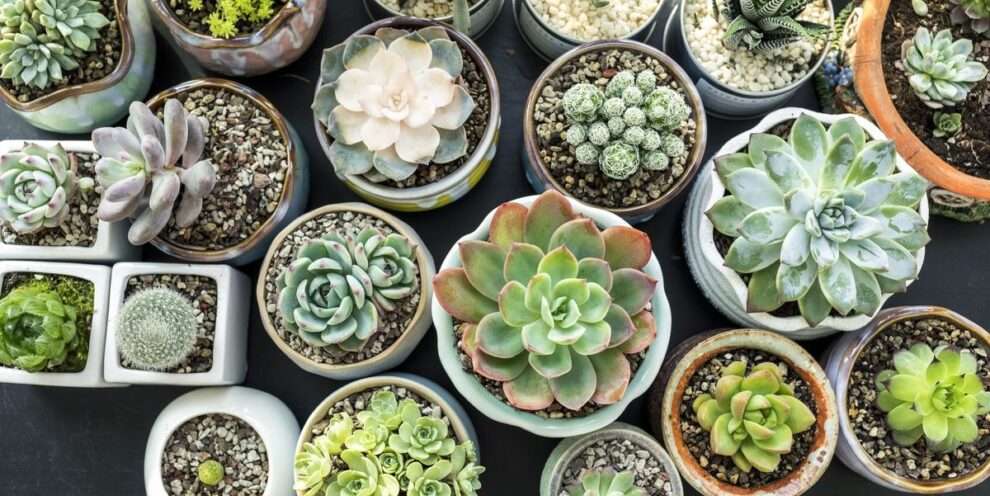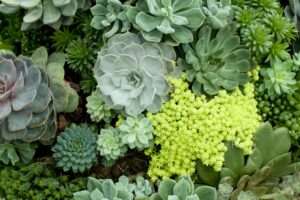Succulents are unique and beautiful plants that are known for their ability to store water in their leaves, stems, and roots, making them incredibly resilient and low-maintenance. Whether you’re a seasoned gardener or just starting out, succulents are a great addition to any home or garden.
What are Succulents?
Succulents are a type of plant that have adapted to survive in arid environments by storing water in their leaves, stems, and roots. This allows them to withstand long periods of drought and thrive in conditions that would be challenging for other plants. Succulents come in a wide variety of shapes, sizes, and colors, making them a popular choice for both indoor and outdoor gardens.
Some popular types of succulents include the Echeveria, which has rosette-shaped leaves and comes in a range of colors; the Aloe Vera, known for its medicinal properties; and the Jade Plant, which is often associated with good luck and prosperity. Each type of succulent has its own unique characteristics and care requirements, so it’s important to do your research before bringing one home.
Understanding the Watering Needs of Succulents
One of the most important things to understand about succulents is how they store water. Unlike other plants that absorb water through their roots and transport it throughout their entire system, succulents store water in their leaves, stems, and roots. This allows them to survive in dry conditions by drawing on their stored water reserves.
The watering needs of succulents can vary depending on several factors, including climate, pot size, and soil type. In general, succulents prefer well-draining soil that allows excess water to escape quickly. They also prefer to be watered deeply but infrequently, allowing the soil to dry out between waterings. Overwatering can lead to root rot and other issues, so it’s important to find the right balance.
The Role of Drainage in Succulent Health
Proper drainage is crucial for the health of succulents. When water sits in the bottom of a pot without a drainage hole, it can lead to root rot and other problems. This is because succulents are not adapted to sitting in water for extended periods of time. Without proper drainage, the excess water has nowhere to go and can drown the roots of the plant.
In addition to root rot, inadequate drainage can also lead to other issues such as fungal diseases and pests. These problems can be difficult to treat and may even result in the death of the plant. By ensuring that your succulents have proper drainage, you can help prevent these issues and keep your plants healthy and thriving.
How to Choose the Right Soil for Succulents
Choosing the right soil for your succulents is essential for their health and well-being. Succulents prefer soil that is well-draining and allows excess water to escape quickly. This helps prevent overwatering and ensures that the roots of the plant have access to oxygen.
Good succulent soil should be a mix of organic matter, such as compost or peat moss, and inorganic matter, such as sand or perlite. This combination helps create a soil that is light and airy, allowing water to flow through easily. Avoid using heavy or compacted soils, as these can retain too much moisture and lead to root rot.
If you prefer to make your own succulent soil mix, a simple recipe is equal parts potting soil, perlite, and coarse sand. This combination provides good drainage while still retaining some moisture for the plants.
The Dangers of Overwatering Succulents
Overwatering is one of the most common mistakes people make when caring for succulents. It can be tempting to water your plants frequently, especially if you’re used to caring for other types of plants that require more water. However, succulents are adapted to survive in dry conditions and can actually be harmed by too much water.
Signs of overwatering in succulents include yellowing or wilting leaves, soft or mushy stems, and a foul smell coming from the soil. If you notice any of these signs, it’s important to adjust your watering routine and allow the soil to dry out before watering again.
Overwatering can have serious consequences for succulents, including root rot and the development of fungal diseases. These issues can be difficult to treat and may even result in the death of the plant. By being mindful of your watering habits and allowing the soil to dry out between waterings, you can help prevent these problems and keep your succulents healthy.
Signs of Underwatering in Succulents
While overwatering is a common mistake, underwatering can also be detrimental to the health of succulents. Signs of underwatering include shriveled or wrinkled leaves, a wilted appearance, and slow or stunted growth. If you notice any of these signs, it’s important to adjust your watering routine and provide your succulents with the moisture they need.
Underwatering can have serious consequences for succulents as well. When a succulent is not receiving enough water, it will draw on its stored water reserves, causing its leaves to shrink and become dehydrated. This can lead to long-term damage and even death if not addressed.
To prevent underwatering, it’s important to monitor the moisture levels in the soil and adjust your watering routine accordingly. Succulents prefer to be watered deeply but infrequently, allowing the soil to dry out between waterings. By finding the right balance, you can help ensure that your succulents receive the proper amount of water and stay healthy.
How to Water Succulents Without Drainage
If you have succulents in pots without drainage holes, it can be a bit trickier to water them properly. However, there are techniques you can use to ensure that your plants receive the moisture they need without risking root rot.
One method is to use the “soak and dry” technique. This involves thoroughly watering the soil until it is completely saturated, allowing any excess water to drain out of the pot. After watering, allow the soil to dry out completely before watering again. This helps prevent water from sitting in the bottom of the pot and allows the roots to access oxygen.
Another method is to use a watering syringe or spray bottle to apply water directly to the base of the plant, avoiding the leaves and stems. This allows the water to reach the roots without saturating the soil too much.
It’s important to note that succulents in pots without drainage holes will require less frequent watering than those in pots with proper drainage. This is because the excess water has nowhere to go and can lead to overwatering if not careful.
The Benefits of Using Drainage for Succulent Care
While it is possible to care for succulents in pots without drainage holes, using pots with proper drainage offers several benefits. One of the main advantages is that it helps prevent overwatering by allowing excess water to escape quickly. This reduces the risk of root rot and other issues associated with overwatering.
Drainage also helps promote healthy root growth by providing oxygen to the roots. When water sits in the bottom of a pot without drainage, it can suffocate the roots and lead to poor growth and overall decline of the plant.
In addition, using pots with drainage holes makes it easier to monitor the moisture levels in the soil. By simply checking the drainage tray or feeling the soil, you can determine if your succulents need to be watered or if they still have enough moisture.
Common Mistakes to Avoid When Watering Succulents
When it comes to watering succulents, there are several common mistakes that people make. One of the most common mistakes is overwatering, as mentioned earlier. It’s important to remember that succulents prefer to be watered deeply but infrequently, allowing the soil to dry out between waterings.
Another common mistake is not adjusting your watering routine based on the season or climate. Succulents have different watering needs during different times of the year, and they may require less water during cooler months or in humid climates.
Using the wrong type of soil can also lead to watering issues. Succulents require well-draining soil that allows excess water to escape quickly. Using heavy or compacted soils can lead to water retention and root rot.
Finally, not providing enough light can also affect how often you need to water your succulents. Succulents thrive in bright, indirect light and require several hours of sunlight each day. If your succulents are not receiving enough light, they may not be able to use up the water in the soil as quickly, leading to overwatering.
Tips for Maintaining Healthy Succulents with Proper Drainage
To maintain healthy succulents with proper drainage, there are a few best practices you can follow. First, make sure your pots have drainage holes to allow excess water to escape. If you have pots without drainage holes, consider using a layer of gravel or pebbles at the bottom of the pot to help improve drainage.
When watering your succulents, make sure to thoroughly saturate the soil and allow any excess water to drain out of the pot. Avoid watering again until the soil has completely dried out. This helps prevent overwatering and ensures that the roots have access to oxygen.
In addition to proper watering, it’s important to provide your succulents with the right amount of light. Succulents thrive in bright, indirect light and require several hours of sunlight each day. If you’re growing succulents indoors, place them near a south-facing window or use artificial grow lights to provide the necessary light.
Finally, be mindful of the temperature and humidity levels in your environment. Succulents prefer warm temperatures and low humidity, so avoid placing them in areas that are too cold or damp. If you live in a humid climate, consider using a dehumidifier or placing a fan near your succulents to improve air circulation.
Conclusion
Succulents are a popular choice for both indoor and outdoor gardens due to their unique characteristics and low-maintenance nature. Understanding the watering needs of succulents is crucial for their health and well-being. Proper drainage is essential for preventing overwatering and ensuring that the roots have access to oxygen.
By choosing the right soil, monitoring moisture levels, and adjusting your watering routine based on the needs of your succulents, you can help keep them healthy and thriving. Remember to avoid common watering mistakes such as overwatering or underwatering, and provide your succulents with the right amount of light and temperature.
With proper care and attention, succulents can bring beauty and joy to your home or garden for years to come. So go ahead and give succulent care a try – you won’t be disappointed!
If you’re a succulent enthusiast, you may have wondered if these trendy plants need drainage. Well, the answer is yes! Proper drainage is crucial for the health and longevity of your succulents. Without it, excess water can accumulate in the soil, leading to root rot and other issues. To learn more about why drainage is essential for succulents, check out this informative article on GirlsGist.com: Do Succulents Need Drainage?
















Add Comment